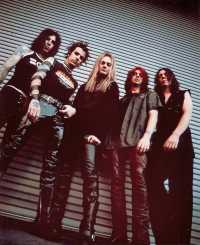With a name like Era, you'd be forgiven for thinking that the Era phenomenon was a group, but Era is, in fact, the work of one man - Eric Lévi. Lévi (who launched his career performing under the stage name Eric Lewy), rose to fame in the 70's with the hard rock band Shakin' Street. Lévi played guitar alongside singer Fabienne Shine, bass-player Corinne Marienneau and Shakin' Street's other guitarist Louis Bertignac.
In 1975, however, Bertignac and Marienneau left Shakin' Street to join the legendary French rock group Téléphone (which went on to dominate the French music scene between 1976 and 1985). Shakin' Street carried on after the departure of the Téléphone defectors, and the group even managed to launch a relatively successful career on the American music scene. Indeed, Shakin' Street soon signed a recording deal with Columbia and they went on to spend the next twelve years based in the States. Shakin' Street recorded two albums together (in 1978 and 1980), but in spite of their respectable career on the U.S. music scene, the group eventually decided to split up in the mid-80's.
Soundtracks
Eric Lévi went on to reinvent himself as a successful solo artist, re-emerging on the French music scene in the 90's as a soundtrack composer. Lévi went on to write music for several famous French films, including Jean-Marie Poiré's 1990 comedy "L'Opération Corned-beef". But it was Lévi's soundtrack for Poiré's box-office smash "Les Visiteurs" which would really catapult him to fame in 1993. (Following the phenomenal success of "Les Visiteurs", Poiré made a sequel - "Les Couloirs du temps : les Visiteurs 2" - in 1998 and Lévi was, of course, invited to write the soundtrack for this film too).
"Les Visiteurs", a time-travel comedy set between the Middle Ages and the present day, proved to be a particularly challenging film as far as the music was concerned. Lévi managed to capture the scenario's frequent shifts between the Middle Ages and the 20th century, by writing a soundtrack which fused medieval-style compositions (à la "Carmina Burana") with computerised synthesisers and electro beats. Poiré's film proved to be a phenomenal hit in France, smashing all previous box-office records and attracting audiences of over 13 million. Naturally enough, Eric Lévi's soundtrack benefited from the phenomenal success of "Les Visiteurs" - and it came as no surprise to anyone when "Enae Volare mezzo", the theme song from the film, went on to become an overnight hit.
The huge success of the "Visiteurs" soundtrack encouraged Lévi to go back into the studio and begin experimenting with more medieval/synth fusions. And it was thus that Era and the album "Ameno" came to life. Lévi's album (released in the spring of '97 under the pseudonym Era) featured eleven tracks which sounded as if they had been recorded beneath the vaults of an ancient cathedral. In fact, nothing could have been further from the truth. As was the case with Lévi's best-selling single, "Enae Volare mezzo", the backing choir featured on the album "Ameno" was recorded in London at the legendary Abbey Road studios (once frequented by the Beatles). Lead vocals were provided by a group of talented singers - Florence Dedam, Harriet Jay, Eric Geisen, Murielle Lefèbvre and Guy Protheroe. Protheroe, a renowned conductor and musician (who had already worked with Lévi on the soundtrack of "Les Visiteurs") was also responsible for conducting the choir on the album.
While Protheroe was supervising the choir at the Abbey Road studios in London, a group of musicians were busy elsewhere in the U.K., recording the guitar and synthesiser parts for "Ameno" at Peter Gabriel's Real World studios. A host of talented musicians were called in to help on Lévi's album. The rhythm section, for example, featured two musicians from Phil Collins's backing group - bass-player Lee Sklar and drummer Chester Thompson.
While the rest of the album was being recorded in the U.K., the rhythm section was actually recorded in Nashville (the home of country music). In spite of the fact that the majority of "Ameno" was composed with the aid of computers and recorded in sophisticated hi-tech studios around the world, the album was infused with a thoroughly medieval atmosphere. In keeping with this Middle Age ambience, the video for "Ameno", the first single release from the album, was shot in a medieval castle in Montségur (in the South of France).
Needless to say, Lévi's medieval/synth fusion proved a huge hit once again, and the Era album "Ameno" was soon rocketing to the top of the charts all over Europe. The album not only proved to be an enormous hit in France, it was also incredibly successful abroad. Indeed, in the space of just twelve months, international sales of "Ameno" topped the 2 million mark! The Era album was distributed in more than 40 different countries - and sales topped the 100,000 mark in seven of these. Interestingly enough, the title track "Ameno" (released as the first single from the album) proved particularly successful in Argentina, where it rapidly became the French Hit of the Year. Following this phenomenal success in the singles chart, Era went on to sell over 250,000 albums in Argentina.
On 20 February 99 Era triumphed at the 'Victoires de la Musique' (the annual French Music Awards), carrying off the award for Best Export Sales of the Year for their album "Ameno".
The following year, in May 2000, Eric Levi re-emerged on the international music scene with a second album entitled "Era 2". While the Era sequel did not rack up the same phenomenal sales as "Era 1", it did sell over a million copies worldwide (including 350,000 in France).
One, two, and three
In February 2003, Eric Levy released a third album under the pseudo of Era. The album entitled ‘The Mass’ was simultaneously released in 55 countries. More powerful than in his previous albums, the tracks merged spiritualism with theatricality and rock’n’roll with pop, electro and classical music.
Source: http://www.sing365.com/music/lyric.nsf/New-Era-Biography/F86D12442ACEE86B48257150002A73CC
